Yet despite this seeming simplicity, granular materials behave differently from any of the
other standard and familiar forms of matter : solids, liquids or gases, and should
therefore be considered as an additional state of matter in its own right. At the root of
this unique status are three important aspects: the existence of static friction, the fact
that temperature is effectively zero and, for moving grains, the inelastic nature of their
collisions. In some cases, such as a sandpile at rest with a slope less than the angle of
repose, static friction produces solid-like behavior: the material remains at rest even
though gravitational forces create macroscopic stresses on its surface. If the pile is
tilted several degrees above the angle of repose grains start to flow, like in a fluid.However,
this flow is clearly not that of an ordinary fluid because it only exists in a boundary
layer at the pile's surface. Also, unlike in an ordinary fluid, kT plays no role in a
granular material and entropy considerations can easily be outweighted by dynamical
effects that now become of paramount importance. Unless perturbed by external
disturbances, each metastable configuration of the material will last indefinitely, and no
thermal averaging over nearby configurations will take place. Because each configuration
has its unique properties, the reproducibility of granular behavior, even on large scales
and certainly near the static limit, can only be defined in terms of ensemble averages.
In order to better understand the dynamical and statistical properties of granular
materials, we have investigated surface flows in a rotating
drum, then studied the response of a granular pile to a
localised surface disturbance. We have also considered the relaxation
of a granular pile, following the occurence of an avalanche. Then we concentrated on the
so-called jamming transition and the glassy behaviours of granular
media. This has lead us to investigate the statistics of the free volumes
inside a static pile. Finally, we have looked at some applications
to dunes dynamics and industrial powders flows.
|
Major results
|
| Surface flows |
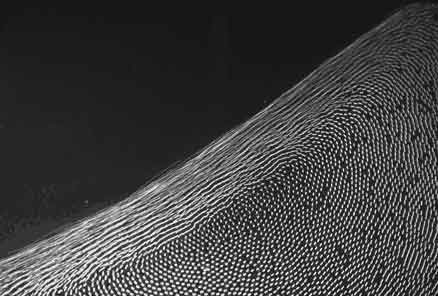 Surface flow on a granular pile inside a rotating drum |
We investigate steady granular surface flows in a rotating drum, measuring the velocity
profile in the flowing layer at the center of the drum, the flowing layer thickness and
the static/flowing boundary profiles. The velocity varies linearly with depth, with a
gradient independent of both the flowing layer thickness and the static/flowing boundary
local slope. Then, writing the depth averaged conservation equations for granular surface
flows, it was possible to find experimentally the constitutive relations needed to close
these equations. Altogether it has brought the evidence that the relation between stress
and strain is non local: |
|
| (i) the velocity gradient is found to be constant in the
flowing layer whereas momentum balance predicts a linear variation of the shear stress
with depth; (ii) the velocity gradient presents a different scaling with the depth for
dense granular flows down a rough inclined plane indicating the non local influence of
boundary conditions on internal rheology inside the flowing layer;
(iii) the velocity gradient does not vanish at the free surface at variance with
typical fluids.
Measuring correlations among moving grains in the flowing layer, we could observe the
first experimental evidence of rigid clusters of grains embedded in the flow and
characterize their geometrical and statistical properties.. Although clustering
instabilities driven by the inelasticity of grain collision are well known in granular
gases, they have never been observed in dense surface flows. We find that these clusters
are fractal and their size is power-law distributed from the microscopic scale - the
diameter of a grain - up to the macroscopic scale - the flowing layer thickness.
Therefore, no characteristic correlation length can be defined in the flowing layer. These
results clearly call for further work in modelizing non-local effects in granular flows. A
collective paper on the subject of granular flows has been written by the participants to
the GDR Milieux DivisÚs.
Figure: Presence of rigid clusters of beads in the flowing layer of 2D flows |
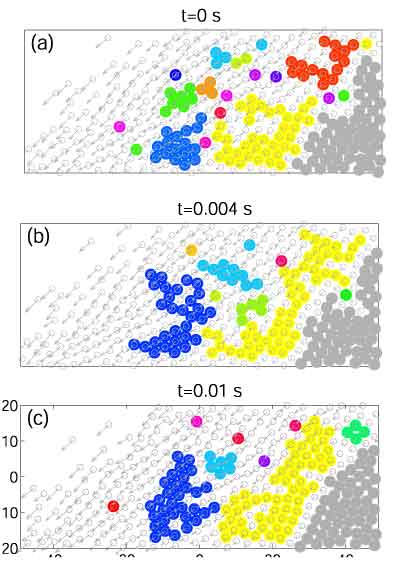 |
|
|
| Relaxation and
response to a localized perturbation |
A number of experimental works have studied surface instability of a granular heap, namely
avalanches, and have led to the conclusion that such avalanches do not behave in a
critical manner at all. In recent years, it has also been suggested that the jamming
transition of granular materials could be analog to a glass transition. Further works on
mean field glass models have developed this analogy and tried to unify concepts that had
emerged in both fields, such as the dynamical temperature defined from fluctuation
dissipation relations, and that related to Edwards' statistical ensemble.First, the
micro-displacements generated by a small localized overload at the free surface are
visualized experimentally inside a packing of steel beads. For a triangular packing, beads
rearrangements remain confined in two inverted triangles on both sides of the applied
overload. This pattern disappears for stronger disorder. A simple model allows us to
account for these observations and to relate them to the stress function response measured
via photoelastic visualizations.
We have then reconsidered the avalanching pile problem but, instead of focusing on
avalanches statistics, we have studied the relaxation of the pile towards mechanical
equilibrium following an avalanche. We first have shown that the dynamics exhibits
non-trivial relaxations and is much slower than expected given the
"microscopic" time-scale. We observed intermittent bursts which reactivate the
pile activity and identified them with correlated movements in space and time.
Perturbation experiments have allowed us to confirm the emergence of strong spatial
correlations when increasing the pile slope, which are reminiscent of the clusters that we
observed in flows. Finally we have extracted in the unperturbed case a two-time relaxation
function, which can be shown to rescale in an aging like manner with a `reparametrization'
of time suggested by a simple model that we introduce in order to describe our
experimental data. Moreover, this model allows to relate the above relaxation function to
a two-time correlation function which shares strong similarities with auto-correlation
functions appearing in aging systems.
|
| Glassy behaviour of a
bidimensional granular media |
Granular media, commonly refered to as a-thermal systems, obey a dissipative dynamics a
priori very different from an Hamiltonian evolution. However everyday life and recent
experiments suggest that a thermodynamical description of granular media might be
feasible. Especially in the context of gentle compaction of grains, strong similarities
with the behaviour of thermal glassy systems have been underlined.
We study the microscopic behaviour of granular
materials under cyclic shear. The goal of these experiments is to find a microscopic
ground for these similarities evidenced in previous studies.
Following tracers, we show that the particle motion is subdiffusive and that the
trajectories exhibit strong cage effect of the kind observed in colloidal glasses. By
direct visual observations, we investigate the cage properties (size, elapsed time in a
cage...) and relate them to the global properties of the material. Further statistical
characterization of the motion are studied in an attempt to identify relevant lengthscales
and ultimately the physical nature of a ”cage”. More specifically, it was
possible following all particles to compute four-points correlation functions, the
behaviour of which allows to identify a dynamical lengthscale. Also the experiment allows
both temporal and spatial resolution so that we could observe the spatial heterogeneities
of the time relaxation.
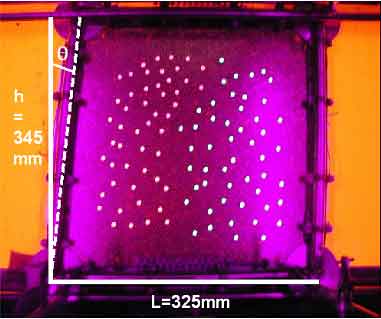
|

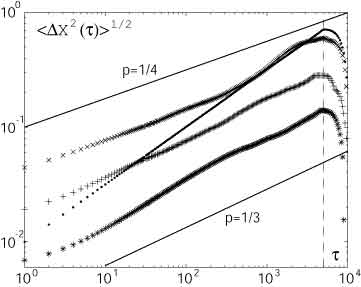
|
| On the left : prototype of the experimental set up. On the
right (top): Cage trajectories at different amplitude of shear cycles. On the right
(bottom): Diffusion properties. |
|
|
|
| Statistics of free volumes
inside a static pile |
Given the above similarities between granular media and glass formers, and given that
granular media consist in a large number of grains, there is a strong motivation for
providing a statistical ground to a thermodynamical description. It has been argued
by Edwards and collaborators that the dynamics is controlled by the mechanically stable
— the so-called blocked — configurations and that all such configurations of a
given volume are statistically equivalent This immediately leads to the definition of a
configurational entropy and the associated state variable, the compactivity, the formal
analogy of a temperature. First attempts to test this flat measure assumption have been
conducted. However, clear evidence in real granular media is still lacking.
We study the full probability
distribution of the volume, not only at the scale of the packing but for subsystems of
increasing sizes. Apart from the expected exponential weight, most of the information
about the system lies in the entropic pre-factor dependance. We have shown that the
specific free volume per particule inside a cluster of size N follows a Gamma-law
distribution, which allow the proper definition of two intensive parameters. However there
is strong evidence of non extensivity suggesting long range correlations. |
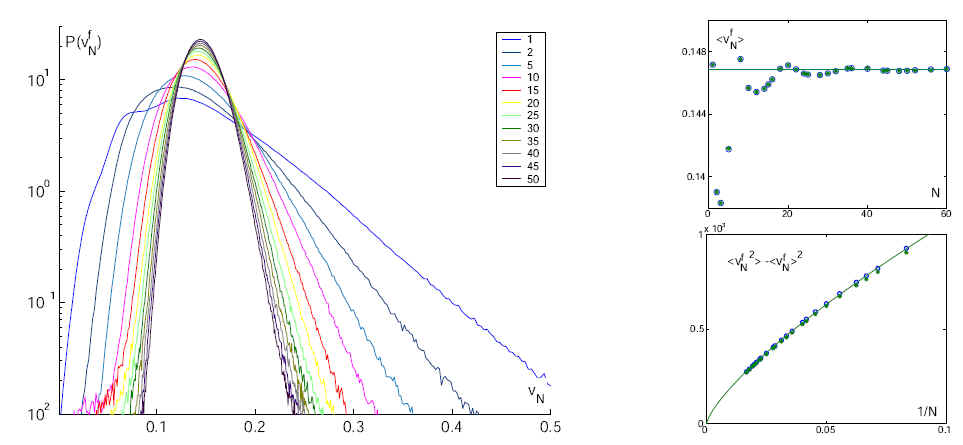 |
Free volume
statistics. (a): distributions of the free volume per grain inside clusters of N grains;
the larger N, the narrower the distribution. (b): dependence on N of the first (top) and
second (bottom) moments of the free volume distributions. |
| Applications:
dunes dynamics and metallic powders |

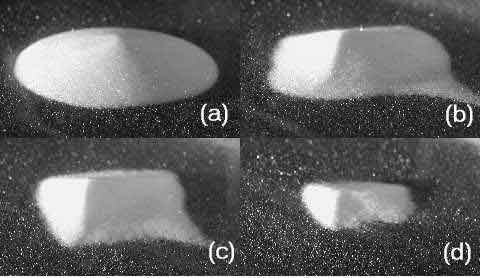
|
Dunes dynamics has strong impact on the ecology and the economy of sandy areas, but is far
from being understood. Since the work on sand dune formation by R.A. Bagnold, a world wide
inventory of dunes has been developed. The most common dune, the so-called barchan, has a
typical crescent shape normal to the wind, with arms downwind and forms under
mono-directional winds. Various models call for more experimental data. On one hand, field
measurements are difficult to perform and often incomplete. On the other hand, it is
believed that dunes have a minimal size of the order of one meter, not reducible to
smaller laboratory scales. We have set up a wind channel where to conduct experiments with
sand and we have shown experimentally that an initial sand pile, under a wind flow charged
in sand, flattens and exhibits a typical barchan shape before disappearing. An evolution
law has been proposed for the profile and the summit of the dune. The dune dynamics is
shape invariant. The invariant shape, the "dune function", was isolated. Our
results, which clearly demonstrates the feasibility of dunes in the lab, open a new way of
investigations in desert studies.Figure :Evolution of a sand pile towards a
"barchan" dune when submitted to a wind saturated in sand |
| In collaboration with CEA/Grenoble (DRT/DTEN), we have
studied problems related to metallic powder flows in industrial processes. In particular,
the filling of containers must be reproducible, homogenous and as fast as possible while
the powders consist in complex mixing of different components. We have started
characterizing the behaviour of model powders using a rotating drum and flows in
cylindrical tubes. Though the powders are very similar (composition, granulometry), very
different behaviors can be observed. Figure : Two very different behaviors after
avalanche for almost identical powders. (a): static slopes; (b): relaxation front |
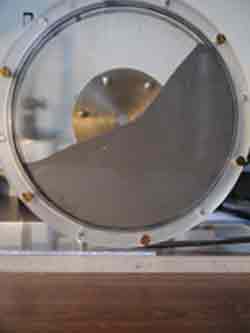 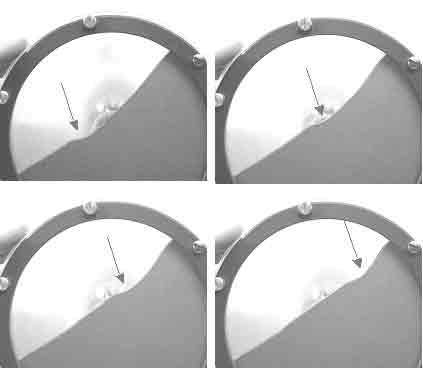 |
|
|
Collaborations
|
|
|
Publications and Contributions to Scientific
Meetings
|
You
will find here a selection of our papers in the field,
- D. Bonamy, F. Daviaud, L. Laurent, M. Bonetti, J.P. Bouchaud, "Multi-scale
clustering in granular surface flows", Phys. Rev. Lett. 89, 034301 2002. (pdf)
- D. Bonamy, F. Daviaud, L. Laurent, "Experimental study of granular surface flows
via a fast camera: a continuous description", Phys. Fluids 14, 1666-1673, 2002
(pdf).
- D. Bonamy, S. Bernard-Bernardet, F. Daviaud, L. Laurent, "Micro-displacements
induced by a local perturbation inside a granular packing", Phys. Rev E, (pdf)
- S. Deboeuf, E. Bertin, E. Lajeunesse, O. Dauchot, "Jamming transition of a granular
pile below the angle of repose", accepted in Eur. Phys. J. B (pdf)
- O. Dauchot, F. LÚchenault, C. Gasquet, F. Daviaud, "Barchan dunes in the
lab", C. R. Mecanique 330, 185-191, 2002 (pdf).
- GDR Midi, a collective work, "On dense granular flows" EPJ E 14, 341-365, 2004
(pdf)
- E. Bertin, O. Dauchot & M. Droz, "Temperature in Nonequilibrium systems with
conserved energy", PRL 93, 230601, 2004 (pdf)
- E. Bertin, O. Dauchot & M. Droz, "Non-equilibrium temperatures in steady-state
systems with conserved energy", PRE, condmat/0412071 (pdf)
- G. Marty & O. Dauchot, "Subdiffusion and Cage Effect in a Sheared Granular
Material", PRL 94, 015701, 2005 (pdf)
- O. Dauchot, G. Marty and G. Biroli, "Dynamical Heterogeneity close tot he jamming
transition in a sheared granular material", accepted in PRL, 2005 (pdf)
- S. Deboeuf, O. Dauchot, L. Staron, A. Mangeney & J.P. Vilotte. "Memory of the
Unjamming transition during cyclic tilting of a granular pile", accepted in Phys Rev
E., 2005 condmat/00005480 (pdf)
- F. da Cruz, F. Lechenault, O.
Dauchot and E. Bertin "Free volume distributions inside a bidimensional granular
medium", in Proceedings of Powders and Grains, Stuttgart, 2005. (pdf)
- For a review see the Lecture Notes
: O. Dauchot, "Glassy behaviours in a-thermal systems, the case of granular
media", Luxembourg University, 2005, (pdf).
as well as pdf files of a selection of oral
presentations
- Jamming transition of a granular pile. "A first step towards athermal
glasses", UCGMG, 2003, ITALY (pdf).
- Clusters in granular flows. "Elements of a non-local rheology", University of
Geneva, 2003, SUISSE (pdf)
- Subdiffusion and Cage effect, Oxford Meeting, 2004 (pdf)
For
a Review : Lecture in Luxembourg "Glassy
behaviours in a-thermal systems, the case of granular media", 2005 Luxembourg (pdf)
|
